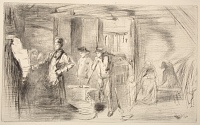Etchings Institutions search term: walker art gallery
The Forge | ||
| Number: | 86 | |
| Date: | 1861 | |
| Medium: | drypoint | |
| Size: | 197 x 319 mm | |
| Signed: | 'Whistler.' at lower right | |
| Inscribed: | '1861' at lower right | |
| Set/Publication: | 'Thames Set', 1871 | |
| No. of States: | 6 | |
| Known impressions: | 95 | |
| Catalogues: | K.68; M.68; T.57; W.63 | |
| Impressions taken from this plate (95) | ||
KEYWORD
TITLE
'The Forge' (1863, Royal Academy). 1
'The Forge' (1863, Whistler). 2
'The Forge' (1871, Ellis & Green). 3
'Blacksmith’s Forge' (1872, Cincinnati). 4
'The Forge. Brittany' (1881, Union League Club). 5
'The Forge' (1886, Frederick Wedmore (1844-1921)). 6
Although the Union League Club was perfectly correct in placing the scene as Brittany, this was clearly not Whistler's title, and 'The Forge' has been almost universally accepted.
1: London RA 1863 .
2: Whistler to W. H. Carpenter, 3 August 1863, GUW #11109.
3: A Series of Sixteen Etchings of Scenes on the Thames.
4: Cincinnati 1872 (cat. no. 972).
5: New York 1881 (cat. no. 89).
6: Wedmore 1886 A (cat. no. 63).
DESCRIPTION
SITE
Beatrice Whistler later recorded the drypoint, presumably with Whistler's approval, as 'Forge - (The.), Brittany'. 7 The Pennells identified it as a forge in the small town of Perros-Guirec in Brittany. 8
7: B. Whistler, list, [1891/1892], GUW #12715.
8: Pennell 1908 , I, p. 94.
DISCUSSION
Lochnan suggested that it recalled the painting Les Forgerons: Souvenir de Tréport by François Bonvin (1817-1887) in the Musée des Augustins, Toulouse, which Whistler could have seen at the Salon in 1857:
9: The Whitesmiths, Impasse des Carmélites [c092], The Forge, Passage du Dragon [c102], The Smith, Passage du Dragon [c103], The Master Smith [c120], The Sunny Smithy [c121], The Good Shoe [c122], Father and Son [c123], The Strong Arm [c125], The Blacksmith [c127] and The Brothers [c128].
10: r.: The Blacksmith's, Howth; v.: Horse in a stable [m1619]; The Little Forge, Lyme Regis [y442].
11: Lochnan 1984 , pp. 134-135, pl. 173.
